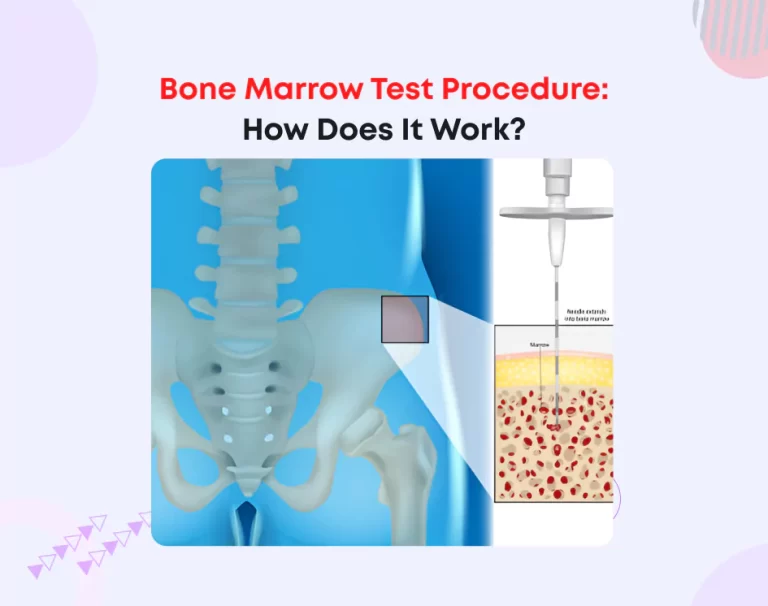
Bone Marrow Test Procedure: How Does It Work?
If you’re facing unexplained fatigue, infections, or abnormal blood counts, your doctor may recommend a bone marrow test. But what is a bone marrow test, and what steps are involved in the procedure?
A bone marrow test is a medical procedure that helps doctors diagnose and monitor various blood and bone marrow disorders. Though it might sound intimidating, the process is more straightforward than most people think.
In this blog, we’ll break down the bone marrow test procedure, its types, purpose, and what you can expect before, during, and after the test.
What Is Bone Marrow?
Bone marrow is the soft, spongy tissue found inside bones, especially the hip and thigh bones. It plays a critical role in producing:
- Red blood cells (carry oxygen)
- White blood cells (fight infections)
- Platelets (help with blood clotting)
A bone marrow test allows doctors to examine the quality and quantity of these blood cells and the condition of the marrow producing them.
Why Is a Bone Marrow Test Done?
A bone marrow test is commonly used to:
- Diagnose blood disorders like anemia or leukemia
- Identify bone marrow infections
- Detect cancer that has spread to the bone marrow
- Evaluate unexplained fevers or abnormal blood counts
- Monitor the effectiveness of treatments for conditions like cancer or infections
Types of Bone Marrow Tests
Bone marrow testing is primarily divided into two types.
1. Bone Marrow Aspiration
This involves withdrawing a small amount of liquid marrow using a thin needle. It helps assess the types and numbers of blood cells.
2. Bone Marrow Biopsy
A thicker needle is inserted to extract a small sample of solid marrow tissue. This helps examine the marrow’s structure and identify diseases that may not appear in the liquid sample.
Often, both procedures are done together during the same appointment to get a comprehensive analysis.
Preparing for a Bone Marrow Test
Before the procedure, your healthcare provider will:
- Review your medical history and current medications
- Conduct blood tests
- Explain the process and answer any questions
- Ask you to sign a consent form
You may also be advised to stop certain medications like blood thinners before the test.
Tip: Wear comfortable clothing and have someone accompany you, especially if you’re receiving a sedative.
How Is the Bone Marrow Test Done?
Here’s a step-by-step overview of what typically happens during a bone marrow test:
1. Positioning the Patient
You’ll be asked to lie on your side or stomach, usually on an exam table. Most often, the sample is taken from the back of your hip bone.
2. Cleaning and Numbing the Area
The doctor cleans the skin and injects a local anesthetic to numb the area. You may feel a slight sting or pressure, but not sharp pain.
3. Bone Marrow Aspiration
A thin needle is inserted into the bone.
The doctor uses a syringe to pull out a small amount of liquid marrow.
You might feel a pulling or pressure sensation.
4. Bone Marrow Biopsy (if needed)
A larger, hollow needle removes a small, solid section of bone marrow tissue for testing.
The process may take a few minutes and can cause brief discomfort.
5. Post-Procedure Care
A bandage is applied to prevent infection.
You’ll rest for a short time under observation, especially if sedated.
Is the Bone Marrow Test Painful?
Most people experience mild to moderate discomfort. The anesthetic helps reduce pain during the procedure. The aspiration may cause a sharp, brief pain, and the biopsy might feel like deep pressure.
Post-procedure soreness at the site is normal and usually subsides in a few days.
What Happens After the Test?
After the procedure:
- Rest for the day and avoid strenuous activities
- Take over-the-counter pain relief if needed
- Watch for signs of infection like swelling, fever, or discharge
Once collected, the bone marrow samples are forwarded to a laboratory to be examined under a microscope. It may take several days to a week for results to come in, depending on the tests ordered.
Risks and Complications
Bone marrow tests are generally safe. As with most medical procedures, there are some associated risks to consider.
- Pain or bruising at the site
- Bleeding
- Infection
- Rare allergic reactions to anesthesia
Follow your doctor’s advice to avoid problems after the test.
How to Recover After a Bone Marrow Test?
Here are a few bone marrow test recovery tips:
- Keep the biopsy site clean and dry
- Don’t lift heavy things or do hard physical work for a couple of days.
- Take medications as prescribed
- Stay hydrated and rest
If you have persistent pain, bleeding, or a fever, get in touch with your doctor right away.
Conclusion
While it might sound scary, a bone marrow test is an important procedure that gives doctors vital, life-saving information. Whether you’re being tested for a blood disorder, infection, or cancer, understanding the procedure helps reduce anxiety and prepares you better.
If your doctor has recommended a bone marrow test, don’t panic. It’s a safe, efficient way to get the answers needed to guide your treatment.
Always consult with your doctor for personalized guidance and support throughout the process.






